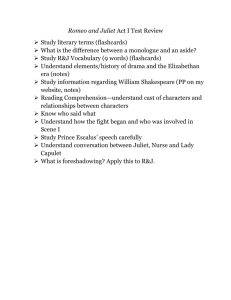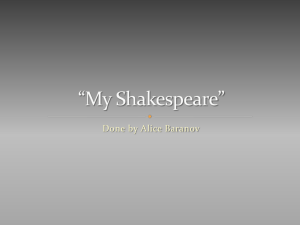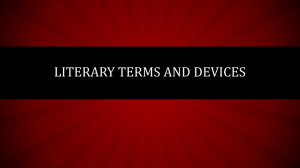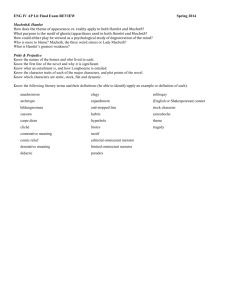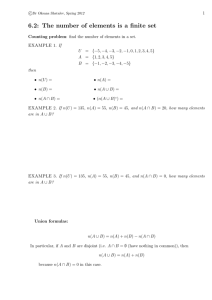Elizabethan Drama Images
advertisement
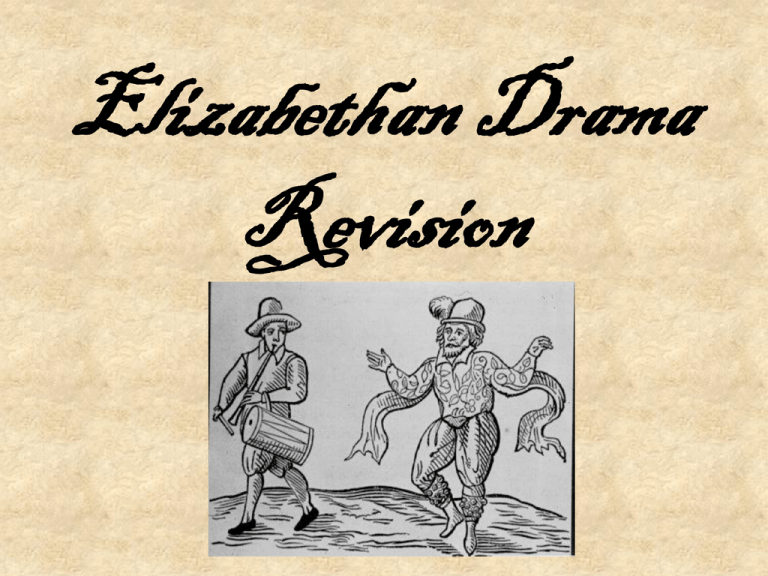
Elizabethan Drama Revision Audience/Actor Relationship • The main action took place on the main stage and, because it was surrounded on three sides by the audience, the thrust stage made for an intimacy we do not get today on the conventional stage with a proscenium arch. • The actors had to play to the audience all three sides. Shakespeare's writing is indicative of this e.g Macbeth - ‘Tomorrow, Tomorrow and tomorrow.” Juliet ‘Romeo, Romeo, Romeo’ • Soliloquies could appear to be spoken confidentially to the audience eg. Macbeth ‘Is this a dagger I see before me…”and 'asides' were less artificial than they often are today. • • • • • Lighting The outdoor theatre performances always took place in the light as there was no electricity in those times. The theatres were open air and light would come in through the roof. Shakespeare therefore had to establish different times of day and night by the words of the play. For example, "The iron tongue of midnight hath told twelve" from A Midsummer Night 's Dream or "The moon shines bright" from A Merchant of Venice, Duration of Time is also effectively conveyed through the words of the play and we are frequently urged through a considerable period of time in a matter of minutes by constant time references. Take for instance, the murder of Duncan in Macbeth Act II, scene i; it begins with a discussion between Banquo and Fleance: B. How goes the night, boy? F. The moon is down; I have not heard the clock. B. And she goes down at Twelve. F. I take't 'tis later, sir. The scene then progresses through, "the king's a-bed" . . . "Good repose", to the knocking on the door and Macduff and Lennox greeting Macbeth with "Good-morrow, noble sir!" Use of Space • The ceiling of the stage would be painted with celestial images to represent heaven. • The curtained recess at the back would be used, for instance, for the Capulets' tomb in Romeo and Juliet or for Desdemona's bedroom (Othello) • The balcony, for Juliet's bedroom. • The area below the stage represented hell. A trapdoor to the space below the stage would be an entrance for the witches (Macbeth) or Ophelia's grave (Hamlet). Properties • There was no scenery or scene painting as such, and the imagery in the speeches was used to help create a picture in the audiences mind. • However plenty of stage properties, such as swords were utilized. Sound • There were realistic noises off, sometimes from the 'heavens' - for example, in the storm in King Lear. Lear's words: "Blow, winds, and crack your cheeks! rage! blow!" would be accompanied by appropriate noises of thunder from above; in other plays, the sounds of battle would be heard from behind the stage and from under the stage would come such sounds as the music 'Under the earth' in Antony and Cleopatra or the Ghost in Hamlet saying "Swear!" Costume and Make-Up • Costumes were elaborate and lavish (hand me downs from rich patrons) but it appears that there was little attempt to present historical or cultural accuracy. • As soon as a character walked on the stage the fabric and colour of his clothing would indicate the role of the character he was playing - Elizabethan Nobles and Upper classes wore clothing made of velvets, furs, silks, lace, cottons and taffeta. • Young boys were hired to act in the female roles. Elizabethan Women's clothing was elaborate and was constructed with many layers of clothing. It would have taken some considerable time, and the help of a dresser, to dress in the costume of a female. Wigs, or periwigs as they were called, were readily available as they were in fashion at the time so this was not a costume problem. However, the make up used by Elizabethan women was! It was lead based and highly poisonous! The young boy actors were therefore very unhealthy, had unpleasant facial skin diseases and a high proportion actually died of poisoning.
